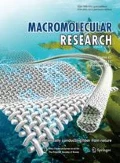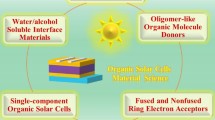Abstract
Thienoquinolinone (TQO) is a promising electron-accepting building block for donor–acceptor-type semiconducting copolymers in organic photovoltaic cells. Polymer donors comprising TQO and benzodithiophene (BDT) exhibited relatively wide bandgaps and deep frontier molecular orbital energy levels. In this study, a new TQO-based electron-accepting building block (BTQ), comprising two TQO units with a thiophene π-bridge, was designed and synthesized to induce broad absorption. Two copolymers were synthesized by Stille coupling polymerization: one comprising BDT and BTQ (PBDT-BTQ) and the other comprising fluorine-substituted BDT and BTQ (PFBDT-BTQ). These polymers showed red-shifted absorption compared to the corresponding TQO-based copolymer (PBDT-TQO) owing to extended π-conjugation. Organic photovoltaic cells based on copolymer: IT-4F were fabricated and characterized. The fabricated devices showed a maximum power conversion efficiency of 8.55%.
Graphical abstract






Similar content being viewed by others
References
Y.-J. Cheng, S.-H. Yang, C.-S. Hsu, Chem. Rev. 109, 5868 (2009)
Y. Sun et al., Nature 440, 908 (2006)
J.C. Scott, L.D. Bozano, Adv. Mater. 19, 1452 (2007)
Y. Shirota, J. Mater. Chem. 10, 1 (2000)
Y. Li et al., Adv. Energy Mater. 11, 2003408 (2021)
Y. Xie et al., Adv. Funct. Mater. 28, 1800627 (2018)
Y. Li et al., Adv. Energy Mater. 8, 1701791 (2018)
J. Qin et al., Adv. Funct. Mater. 30, 2002529 (2020)
K. Fukuda, K. Yu, T. Someya, Adv. Energy Mater. 10, 2000765 (2020)
F. Liu et al., Adv. Mater. 33, 2100830 (2021)
Y. Cai et al., Adv. Mater. 33, 2101733 (2021)
C. Li et al., Nat. Energy 6, 605 (2021)
Q. Liu et al., Sci. Bull. 65, 272 (2020)
Y. Xu et al., Adv. Mater. 33, 2101090 (2021)
S. Zhang et al., Adv. Mater. 30, 1800868 (2018)
W. Zhao et al., J. Am. Chem. Soc. 139, 7148 (2017)
J.-W. Ha et al., J. Mater. Chem. C 8, 12265 (2020)
J. Huang, Y. Li, Front. Chem. 6, 341 (2018)
D. Qian et al., Macromolecules 45, 9611 (2012)
J. Yuan et al., Polym. Chem. 4, 4199 (2013)
X. Wang et al., Macromolecules 45, 1208 (2012)
J.-H. Kim et al., Energy Environ. Sci. 7, 4118 (2014)
H.J. Son et al., J. Am. Chem. Soc. 133, 1885 (2011)
Acknowledgements
This study was supported by a National Research Foundation of Korea (NRF) grant funded by the Korean government (NRF-2020R1A2C2008757 and NRF-2021R1C1C2007445).
Author information
Authors and Affiliations
Corresponding author
Ethics declarations
Conflict of interest
The authors declare no competing financial interest.
Additional information
Publisher's Note
Springer Nature remains neutral with regard to jurisdictional claims in published maps and institutional affiliations.
Supplementary Information
Below is the link to the electronic supplementary material.
Rights and permissions
Springer Nature or its licensor (e.g. a society or other partner) holds exclusive rights to this article under a publishing agreement with the author(s) or other rightsholder(s); author self-archiving of the accepted manuscript version of this article is solely governed by the terms of such publishing agreement and applicable law.
About this article
Cite this article
Ha, JW., Jung, J.G., Ryu, D.H. et al. Thienoquinolinone-based acceptor-π-acceptor-type building block for polymer donors in organic solar cells. Macromol. Res. 31, 25–31 (2023). https://doi.org/10.1007/s13233-023-00112-1
Received:
Revised:
Accepted:
Published:
Issue Date:
DOI: https://doi.org/10.1007/s13233-023-00112-1




